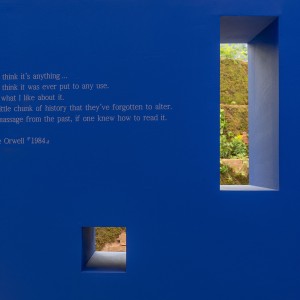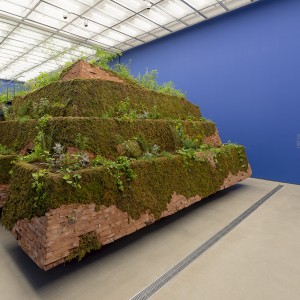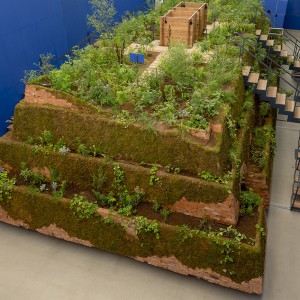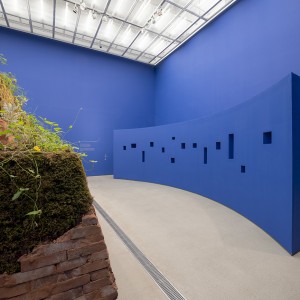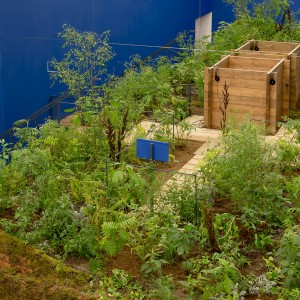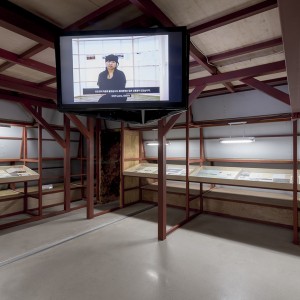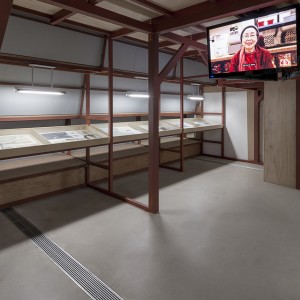Na Hyun

In process of performing such wide directional projects with intense data research, official documents, interviews, production and installation, video and photographical recordings, Nahyun identifies that objective truth suggested from objective historical sources can be entirely obscure.
Interview
CV
22014
<PRO-JECT>, LIG Art Space, Seoul, Korea
<Na Hyun’s Solo Exhibition>, E&C Gallery, Fukui, Japan
2012
<A Song for Lorelei>, Art Space Jungmiso, Seoul, Korea
2011
<Na Hyun Report – About the Ethnic>, Sungkok Art Museum, Seoul, Korea
<Major Group Exhibitions>
2014
<Unfinished Narrative: MMCA Residency Exhibition>, Korean Cultural Center India, New Delhi, India
<Meditation Biennale 2014>, Poznan, Poland / Berlin, Germany
2013
<Trasfer Korea-NRW>, Arko Art Center, Seoul, Korea/Hagen, Germany
<Hermes Foundation Missulsang>, Atelier Hermes, Seoul, Korea
<Reportage>, LIG Art Space, Seoul, Korea
Critic 1
Obelisk of Imaginary Aesthetics Built in the Square of History:
Na Hyun’s Docu-Art Project and Aesthetic Truth
Gim Jong Gil (art critic)
“My interest lies not in the images of the photographed subject, but in the perspective to look at and show the subject. This might seem a little dry, but I hope people can acknowledge that such different languages exist within art. It would be a shame if people just boycotted these ideas for being too messy or for representing an unfamiliar grammar. Since my works are characterized by the building of an archive, it’s always difficult to put a period on the end. The vocabulary of “project” is quite fitting for my works, because I usually “project” something, throw it forward and see what happens. I focus on presenting a new perspective rather than repeating the existing order. Thus, I think that the essence of my works lies in the process itself, rather than in something complete.”
Na Hyun
I. Reasons for Recommendation
Over the last decade, Na Hyun has been accumulating resources to create an archive of historical events and records, continuously carrying an aesthetic co-evolution project that expands the reality of documentary. There surely have been other archival art projects, but these docu-art projects are characterized by an utterly unique “Na Hyun-style” that only he can elicit. As such, Na Hyun’s astonishing and aesthetic “studies of the encyclopedic archives” effectively fill in the blanks of historical events with artistic imagination. His projects encompass history, cultural anthropology, ethnography, and museology, while exemplifying meticulous collection, analysis, and structural rearrangement. This endeavor may serve as a new public sphere of art, the likes of which Korean contemporary art has thus far failed to produce.
Na Hyun stated that he “provides objective historical materials, while simultaneously demonstrating that objective truth can be highly ambiguous.” The public sphere of art represented by his docu-art projects is distinct from the aesthetical investigations of more familiar genres, such as painting, sculpture, and photography. In terms of the design of the exhibition space, the works are linked to museology, with an emphasis on museums’ role as archives of historical materials. In actuality, however, they are based on the use of “imaginary relativism” to overcome the limitations of “historical positivism.” Na Hyun collects and displays numerous historical materials, as if he were organizing the exhibition space from the perspective of historical materialism. But in fact, rather than allying himself with historicism, he structuralizes the relativistic imagination of art as a way to overcome historicism. His strategy is not to identify “historical truth” through the historical materials. After all, historical materials are inherently “partial,” such that they can only ever reference reality, rather than represent the “absolute truth.” Therefore, his strategy is to pose lively questions that fluidly intertwine among the historical materials, creating an intersection where the positivistic theory of history and the imaginative theory of aesthetics collide. This intersection is the stage where we can witness new aesthetic experimentations of the twenty-first century.
Another reason for my recommendation is the exemplary level of completion that characterizes Na Hyun’s art. In carrying out such omnidirectional and international projects, he must meticulously plan every detail and conduct extensive research, which includes drawing up official documents, conducting interviews, taking photographs and video, and of course, producing and installing the work. Depending on the systems, methods, and plans, the projects take months or even years to execute, and they often require a huge budget. Furthermore, due to the nature of his projects, he cannot complete his exhibition without publishing reports and sourcebooks of archive results. As such, the culmination of his work is actually the publication of his high-quality, comprehensive reports and sourcebooks, which magnificently convey the purposes of the projects that he has so scrupulously designed and executed.
Based on the unparalleled level of planning, design, documentation, and execution of his docu-art projects, I am recommending Na Hyun for the Korea Artist Prize 2015.
II. Works of Na Hyun
The exhibition, PRO-JECT (November 27-December 31, 2014) at LIG Art Space might be considered as the “homage-collage” of the inclusive project that he had planned and executed so far. Although the exhibition may not have represented a single independent art project in its entirety, it provided an up-close and in-depth view of the oeuvre that Na Hyun has been constructing. The exhibition space was organized as if to present an overview of his works. Like a retrospective that displays the achievements of “studies on encyclopedic archives,” the exhibition examined the space of the “Na Hyun museum.” Focusing on the projects featured in the exhibition, I will briefly introduce his art and works.
A. Babel Tower Project (2012 to present)
Nahyun’s most recent project, Babel Tower Project deals with Berlin’s Mt.Teufelsberg, a mountain made of the remnants of the second World War, as well as Seoul’s Nanjido, the site of accumulating waste from the city’s modernization and urbanization. The project represents Nahyun’s attempt to reinterpret these historical traces of two cities as a contemporary Tower of Babel. The history of Teufelsberg began after the Second World War, when about sixty hills were suddenly formed in various parts of Germany, including eighteen hills that were made from the rubble caused by the extensive bombing. At approximately 120 meters in height, Berlin’s Teufelsberg is the tallest of the artificial hills, and it is said to have been created primarily by local women bringing rubble that, at one point, amounted to about eighty truckloads per day. During the Cold War era, the hill was the site of wiretapping and surveillance equipment of the U.S., as part of the clandestine “Echelon” spy-network that allowed the National Security Agency (NSA) to surveil the world with the utmost secrecy. After German reunification, the hill was sold to an investment company, but the company went bankrupt and the plans to develop Teufelsberg went back to square one. In Korea, the history of Nanjido is well known, so I will not recapitulate it here. By comparing these two monstrous traces of major cities with the Tower of Babel, Na Hyun addresses issues of desire and miscommunication. Although he collects and reveals old materials associated with historical facts, he never purports to use those facts and materials to approach any certain truth. Paradoxically, by focusing not on certain “truth,” but on a “certain” truth, he presciently evokes the chaos and confusion of multi-lingual miscommunication.
B. A Song of Lorelei project (2010-2013)
This project is the same or similar to the Pile Project 2012 and Na Hyun Report-About Ethnicity. One of the most important motifs of A Song of Lorelei is a fourteenth-century wooden stake from the Stadtmuseum in Düsseldorf, Germany, which was found around the moat of a castle. Using oak wood, Na Hyun produced a huge wooden stake, 2.9 meters in height, which he then drove into the ground near the Rhine River, the boundary that separates nature from the desire of human development, i.e., urbanization and modernization. For the next two years, Na Hyun observed the stake and documented changes to its condition. The fluctuating watermark on the stake reflected the rise and fall of the river, and the stake also began to lean in the direction of the river’s flow.
A similar project with the same format was carried out in Korea. Na Hyun made another 2.9-meter stake and, over a period of time, planted it in four different places: by the Namhangang Bridge (Han River), the Gudam Bridge (Nakdong River), Damyang Lake (Yeongsan River), and the Geum River. He continuously documented the stake’s condition through photography and video. Ironically, Na Hyun’s project coincided with the reckless execution of the controversial “Four Major Rivers Project,” a national landscaping project that was ostensibly intended to revitalize four major rivers and their tributaries. Interestingly, after these proactive steps, Na Hyun’s aesthetic discourse truly emerged from what he did with the stake afterwards: he used it to make a table. While “driving a stake” may signify the process of cynically problematizing the coexistence of nature and people, the use of a stake to produce an object known as a “table” implies aesthetic questions about the “space for the discourse of coexistence.” When various parties meet and interact, the “table” may be the physical place where an intense argument takes place or it may be the minimal manners up for discussion. The title A Song of Lorelei comes from a German folk song about flowing along with the waves of the Rhine River.
C. Missing Project (2006-2009)
This project began with the goal of learning the fate of some French soldiers who went missing in action during the Korean War. Based on historical records and the memories of surviving soldiers who fought with the missing soldiers, Na Hyun delves into the meaning of “missing.” The final exhibition consists primarily of the process of the search for the missing soldiers, i.e., the process itself. He questions the fallacy of the social context inherent in cases of the missing, the belief in memories as truth or substantial entity, and the trust in records or evidence. Taking place over a three-year period, this project truly evinces the extensive archives of history and the sociological consideration of relations. Ultimately, however, what we grasp from the exhibition is not the missing soldiers, but the ambiguity of “missing truth” and “un-disclosed missing.” Among the shadows of the missing that can never be dispelled, Na Hyun reveals an essence of abstract memories, or worn and faded photos.
Critic 2
It’s Anything!
- The History of Na Hyun’s World of Residue and the Aesthetics of Symmetry -
Jong Gil Gim (Art Critic)
I don’t think it’s anything
I mean, I don’t think it was ever put to any use.
That’s what I like about it.
It’s a little chunk of history that they’ve forgotten to alter.
It’s a message from a hundred years ago, if one knew how to read it.1)
1984, George Orwell
1.
Ideas from the footnote 1); Unraveling my thoughts on Na Hyun’s quotation of George Orwell’s, “I don’t think it’s anything”, I had mentioned that Na Hyun has recently occupied an aesthetic site in the unfamiliar wilderness of historical studies by including ‘things that have become regarded as nothing’. ‘Things that are regarded as nothing’ can be described as a ‘world of residues’ in the way of Na Hyun’s expression. I drew a map of ideas deriving from the concept of ‘residue’ after arranging all of his projects in accordance with clues from some events in a bid to conceive my own theories about his art. Each project starts from the fact that the artist himself has no inevitable correlation with the ‘history of events’, but when he is perceived as someone in the world of residues, almost all events travel back to him. In one statement, the artist himself has been the basis of his art. “The underlying element of my projects is an aggressive introduction of the world of residue outside the structure. The structural instability of space and time will be a milestone towards the world of residue and the milestone is like an accelerator in my work”,2) said the artist.
2.
What we can infer from his confession is that his projects have aimed to discover the ‘world of residues’ outside the structure of our own world and that they aggressively acquaint us with this fact. He hints that the ‘world of residue’ is in the ‘outside of the structure’ and that the path to the world refers to “a structural instability’ which itself is none other than a milestone towards the world of residue! It is important to note that the world of residue he is referring to isn’t a mere appropriation of the concept of ‘residues’ as ‘leftovers.’
“In my work I have had an obsession with the concept of the ‘event’. My work’s identity has been triggered by an event and the event a) I think, is closely associated with the intricate, tense relation of space and time. My work studies b) tension arising from the limitation of humanity’s ability to recognize things and attempts to break its stiffness”. This was written by Na Hyun in his source book for the White Cloud Minnow project. In the preface he continued by saying “I’d like to address c) the themes of an encounter and make an exchange with different dimensions in the social structure system of events by inquiring into the dimension of space and time that an event has constructed.” Judging by his thoughts on the complicated relationship between the world of residue and an event, he seems to have been interested in the method of residue. John Stuart Mill, a British philosopher and a proponent of utilitarianism, gave an account of the method of residue as the following: “If subtracting from any phenomenon such part as is known by previous inductions to be the effect of certain antecedents3), i) the residue of the phenomenon is the effect (or cause) of the remaining antecedents”. However, the problem is that II) if the remaining elements are bound up with complicated relationships, save for cause-and-effect relationships, iii) an accurate cause (or effect) cannot be found whereas if the final remaining phenomenon (a) and its cause (A) are clear and simple, the method can be an inductive inference.4) If comparing a), b) and c) in his statement with i), ii) and iii) in the Method of Residue, we come to realize that the world of residue according to Na Hyun is ‘an event’ trapped in ‘a complicated relationship’ as ‘a remaining phenomenon’.
3.
As in the method of residue, the problem is that we cannot find the exact cause (or effect) of a complicated event. Na Hyun’s aesthetic event is paradoxically devised from this point. The fundamental structure of his projects is relatively symmetrical. You may review relative concepts such as <well-known part / remaining phenomenon>, <all cause-and-effect relationships / remaining complexity system>, and <social structure system / problem>. ‘Remaining phenomenon,’ ‘remaining complexity system,’ and ‘problem’ here are ‘relative residues’ that are out of proportion to the ‘well-known part’, ‘all cause-and-effect relationships’, and the ‘social structure system’. For some time he has shined a spotlight on this ‘residue’ of relative residues. To him, residue is not the same as its encyclopedic definition but is a ‘remainder’ that is the opposite of the history of the world and the social structure system (he mentioned that this is outside the structure).
The list of his first residues seem to have been derived from There Is No Change (Naju-Numoon) and There Is No Change (Naju-Hyanggyo) featuring the space-time of Naju, his home in 1999, Let’s Take Off about removing the shades of prejudices and stereotypes, and Weeds that captured the nameless plants in Nanjido, which were all exhibited in his first solo show, Greed (1999). He sheds light unto the ‘nameless plants’ growing in an enormous rubbish heap, presenting a ‘différance of scenes’ in which the past overlaps with the present in the layer of time.
He demonstrates the concept of différance by juxtaposing past and present photographs of a two-story pavilion and a local public school that had been added onto a Confucian shrine in Naju,
his hometown. He wrote 流 (Numoon) and 변화 (Hyanggyo) on the surfaces of the shots in calligraphy alongside scribbled drawings and paint.
The 1999 photograph taken at the same place as his previous one along with the characters he wrote on them bring about a chain of interpretational operations, arousing something called a ‘signification of language.’ As the characters in the photos referring to ‘flow’ (流) and ‘change’ (변화) collide with the title, There Is No Change, any interpretation of the meaning is ‘inevitably’ delayed. This conceptual critical consciousness seems to be philosophically anchored in Jacques Derrida (1930-2004) and his works. Another example is the Weeds from Nanjido. In this work the tiny typed letters of ‘난지도의 잡초’ (Weeds of Nanjido) and ‘잡초도 자신이 잡초라고 생각할까’ (Do weeds think they are weeds?) are put on a painting and ‘根’ (roots) is written in calligraphy.
As he explains in his artist statement, “These are unknown plants growing in Nanjido. From a human’s point of view they are weeds but they themselves may not think so. Just one perspective cannot be the correct answer.” His critical mind toward residues in the Naju scenes was to impede possibilities of semantic interpretations of the multilayered temporality of the past and present, whereas a dehumanized perspective contemplating a surplus or surplus beings as ‘unknown plants’ is brought into the focus with Weeds. The prejudices and stereotypes in his painting Let’s Take Off featuring black sunglasses connotes that this idea derived from his reflective introspection of the human-centered perspective.
4.
Plato expressed his concerns about democracy, defining it as a plethora of desires. Any surplus was in no way considered democratic to him. Order and harmony – both youths and slaves remaining in their ‘given identity’ – were required. Jacuqes Ranciere (1940- ) overturned such thoughts of Plato. He regarded it impossible for unqualified persons who make order and harmony and people who assert that they are whole in their community to dominate, moving beyond the scope of their given rights, qualification, and share, as is the nature of democracy.5) Those who have no shares claim them, becoming ‘surplus’ as those who have no shares or the residue, unknown beings have already been revealed through diverse events in contemporary Korean society as well. Na Hyun’s thoughts about the ‘nameless plants’ in Weeds are scathingly associated with his idea about those who have no shares. His thoughts on the concept of différance (as asymmetrical relativity) and those who have no shares are further deepened in Witch Hunting displayed at his 2001 exhibition, Dissecting Knife. He explores the difference and discrimination among beautiful, ugly and mediocre women. He arrives at a conclusion based on the survey. “My work, Witch Hunting was completed through a survey involving approximately 1,000 people.
The contents of the questions were mostly about the relationships between man and nature that I had perceived. The majority opinion at times worked as violence and overturned the truth, passing over the minority opinion. The truth is something that can be changed”.
5.
Na Hyun’s projects reveal that he had already arrived at a conceptual zero point before leaving Korea to study abroad. Although his exhibited works were still not far away from the border between general painting and rather rough conceptual installation, we can grasp what he tried to see and why he had such critical consciousness of the act of ‘seeing’. The White Cloud Minnow project conducted between 2001 and 2003 can be defined as an aesthetic corpus callosum connecting and distinguishing his projects before 2001 from the ones after 2003. In this project we realize that the artist gave attention not to phenomenological subjects and objects such as landscapes, weeds, and glasses but to the ‘events’ that such objects derive. He seemed to take note that such events are bound up with ‘alienated identity’. 6) Unlike Plato’s ‘given identity’7) this identity is found mainly in unknown residual phenomena, complicated relationships, and outside the social structural system.
I have defined White Cloud Minnow as an aesthetic corpus callosum since his critical consciousness in this project has ‘cerebral symmetry’ in which the unconscious suppressed by the conscious in the structure of reality is animated and tries to proceed to the ‘world of residue’ outside the structure.8) While thinking about this project I had thought that Na had set the zero point from three perspectives: ‘event-as historical event’; ‘space-time-as synchronic structure’; and ‘identity-from two places’. Of course, this zero point is not a single location where all of his projects congregate. Rather, it is just like an antler that grows from two points on the head.
6.
Na Hyun, a man with two antlers. When a reader envisions a man who has antlers, the produced image derives from creative phenomenology that is formed by visual perception of the conscious. As there is no such thing as a man with antlers it can be described as a mythical image. What would it be like if such a man existed in reality? His existence would be a sensational event. This is what Na Hyun is trying to insinuate. His narrative is based on an actual event. The White Cloud Minnow project begins by asking what influence World War II made on Oxford, Britain and Dresden, Germany. The fate of Oxford was the polar opposite of what happened in Dresden: Oxford was largely left intact while Dresden was completely destroyed.
This is an undeniable historical fact. As is widely known, we cannot deny the cause-and-effect relationship of this historical fact any more. Why did the two cities meet different fates? Their two different outcomes are like the concept of having two antlers as these myths are rooted in historical facts. The myths in time turn to creative phenomenology as mentioned above, resulting in the moment when a historical event is transformed into an aesthetic event. The two antlers may have many roots, not just two. They have been rooted in the left and right parts of the brain but the roots might have become tangled up in a knot. As a historical fact metonymically turns into a mythical event, the stronger the light the corpus callosum emits and the stronger the force of a narrative grows. A myth comes to have ‘a symbolic body’ thanks to this bright light. This body is Na’s work. In other words, the ‘reality’ of a mythical narrative is Na Hyun’s aesthetic event.
7.
And yet, we cannot fully understand the structure in which his mythic reality appears as an aesthetic event. We need to consider that even Shinichi Nakazawa might have referred to a wide range of thoughts from Claude Levi-Strauss’ mythology, Pierre Clastres’ theory of the state, and Karl Marx’s critique of political economy to Georges Bataille’s general economy, Jacques Lacan’s topology of the unconscious, and Gilles Deleuze’s theory of multiplicity to complete his concept of anthropology of symmetry.9) The spiral stems of his thoughts and the concepts that he seeks to create a consistent idea meet other spiral stem after moving beyond the zero point of his thoughts. The stems of thoughts bring about hybrid events and differences while intersecting, colliding, and even adhering to one another in this process. Although they are derived from just two spiral stems located on left and right, the complexity of an event grows in the process of being woven and intermingled. The meshes of the net of Na Hyun’s events look a lot like Shinichi Nakazawa’s anthropology of symmetry. As his works have come to have a more extensive radial structure since the White Cloud Minnow project, more meshes have distinctly appeared. His work shows a process in which an event stemming from a root meets another and continues. Their expansion seems rather chaotic. Nakazawa argues that the unconsciousness of symmetry is the nature that brings the mind to operation resulting in a metaphysical world having to be naturalized again. There seems to be no difference between the reality of Na Hyun’s mythical narrative and the naturalization of Nakazawa’s metaphysical world. Something like the discontinuous continuity of the chaotic butterfly effect is Na’s passageway to the ‘world of residue’.
8.
The Missing project launched in 2006 could be said to be the first project he carried out after his deliberation on the zero point of his aesthetic concept.10) The notion of ‘missing’ is a potent ‘realistic event’ that associates war with historical studies, ethnology as global anthropology, and a legend of those coming back alive and those missing from the heroic mythology of war, with the structural system of ‘aesthetics’ in the thought of the world of residue outside the global structure.
Na Hyun focuses on the seven French soldiers who were missing during the Korean War spanning from 1950 to 1953. According to his survey, the Korean government identified eighteen French soldiers as missing while the French government identified only seven. In the end, the French Army archive stated that the actual number was twelve. The number of twelve missing soldiers, the list of their names, documents, and photograph materials secured in the process of investigating the event along with other multifarious materials including videos are not for the aesthetics.
They are nothing but historical records of the world of residue linked to his aesthetic concepts and become part of the aesthetics itself. Historical studies of the world of residue are an aesthetical strategy to excavate the alienated identity of those who have no shares or names. While historical studies encompass ‘history as a fact’ (an event itself) and ‘history as a record’ (a description of an event) as a methodology of social science, Na Hyun’s historical studies of the world of residue is a study of art that intends to be a shadow of historical studies through a rearrangement of the traces of ‘surplus subjects’ wandering in the sea of inaccuracy between fact and record. It may not be proper or critical approach to reveal the process he went through to materialize the list of missing soldiers. What is really required of this essay is to unlock how his historical studies of the word of residue have turned into aesthetics and how we can unveil the nature of such aesthetics. The most notable part of Missing Project was the interviews with former French soldiers who came back alive. The interviewees were very serious while recalling their memories of the Korean War, vividly describing the events that took place. While listening to their comments, I was under the impression that they had fallen into their own wells of memories but that their ‘presence’ was absent in the wells that had been made by the horrible and dreadful event of war. It was not easy to detect the traces of ‘missing’ in their memories, something which might have been the artist’s intention. In other words, those who came back alive are also ‘surplus subjects’. He displayed a list of 12 missing people that was blurred enough so as to be unintelligible at the Young Korean Artists 2008 exhibition organized by the National Museum of Modern and Contemporary Art, Korea. It was an enormous digital print but the names were illegible. They appeared as if they were being viewed by a visually impaired individual. To one with astigmatism, an image can be seen as dispersed, out of focus, or blurred.
9.
The concepts stemming from the events in the White Cloud Minnow project include violence, identity, sacrifice, releasing of the captives, involvement, and historical books. He initially questions why the society tries to visually establish one’s identity in regard to the issues of violence. His consciousness pertaining to this aspect is perhaps irrelevant to our society’s educational system that is influenced by a powerful state ideology since the formation of a modern nation. Although he did not address this issue in this project, Na Hyun Report: About Ethnic (2008-2011) is art anthropology that digs deeply into this matter. He raised the question “What is the concept of nation or ethnic group?” while traversing from Lake Baikal, a site considered to be the origin of Korean descents, to Jeungdo, South Jeolla Province. This could be described as shooting an arrow of synchronic chaos in the present day Korea. All kinds of objects and images he had collected from the trajectory of time and the arrow’s path were related to the blood, culture, and religion of the numerous ethnic groups which fused together to form the East Asian race. The cause of such fusion was at times violent and resulted in separation, migration, and nomadism. Historical studies probably lack the ability to establish ‘an arrow of synchronic chaos’ that was perhaps a cause of all effects. As Na’s report indicates, such material cannot closely form any consistent algorithm by means of any logical consistency and social scientific methodologies. Imagination connects an image to another while the language connecting an object to another is a shaman’s words. As symbols are extremely abstract, it may be impossible to prove the system of an algorithm with aesthetics. The last chapter of Na Hyun’s report is Arbol, Cuba. The first, second, and third generations of Koreans living in Cuba that he met are portraitures of the algorithm, making it possible to prove. This algorithm becomes shattered if one includes the first and third generations but excludes the second. Korean people in Cuba are subjects of the world of residue who are undergoing the ‘alienated identity’. The artist paid tribute to surplus subjects who were sacrificed with a performance that involved scattering sugar over the streets of Cuba.
10.
The sentence “I don’t think it’s anything.” is meant to affirm whatever the object of ‘anything’ is by stressing it and thus firmly acknowledging it. Na Hyun has conducted aesthetic projects to potently affirm ‘something’ his historical studies have lost, seeking the nature of historical events. It’s the same with the Painting Landscape Project (2005-2007), A Song of Lorelei (2010-2013), and The Babel Tower Project (2012-present). His ‘water drawings’ depict images of ‘something’ and leave them as traces of ‘anything’ whereas A Song of Lorelei is meant to invoke the substantial truth of ‘something’ and ‘anything.’ If the result of his projects was merely a performance of erecting posts, his thoughts on cerebral symmetry could not have evolved. In the two projects mentioned above, Na Hyun reveals that the world of residue can be ‘a contemporaneous event’ and the ‘alienation’ that occurs in the present by linking to events from 21st century contemporary Korean history. His thoughts on aesthetics seem to take another turn. The Babel Tower Project, an ongoing project, serves as a turning point in his work. A huge well is set up at the venue but it is difficult to see inside it. We are only able to view the video of an interview being played from inside the well through a mirror suspended from the ceiling. This project is anchored in an imaginary scenario in which Na Hyun regards the Devil’s Mountain of Berlin and Nanjido of Seoul as the ruins of the Babel Tower. He archives, analyzes, and spreads almost all kinds of materials so that he can trace the truth of this fiction. However, there is not enough evidence to support his attempt to narrow the distance between the German and Korean mountains of garbage and the myth of the Babel Tower by associating the Devil’s Mountain, a 120 meters heap of debris in Berlin created following the Second World War, with Nanjido, a place that became a dump site in Seoul from the 1970s. He has to amplify his aesthetic imagination to narrow the distance of space and time between 20th century German and Korean dumpsites and the Tower of Babel. Why did he adopt a well into his work? A well is an object where the myth of ‘anything’ arises, a passageway of transformation from ‘anything’ to ‘something’ and ‘something’ to ‘anything’, a galaxy that a band of light can come in and out of. The well can be a milestone or corpus callosum bridging the reality inside the global structure to the world of residue outside the structure in this context. He tries to present the world of residue as the Tower of Babel to all of us by opening the passageway. Opening the Tower of Babel means making a connection between each zero point. As this ‘something’ is very elemental, it obviously causes the naturalization of a metaphysical world. The sentence “It’s anything” is an aesthetic manifesto that colors a myriad of languages.

